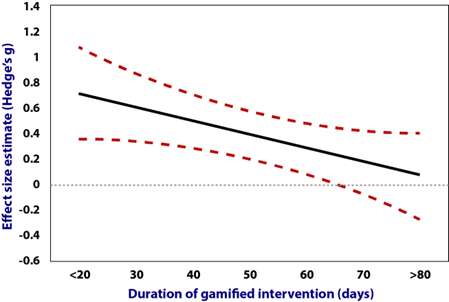Gamification for enhancing adherence to mental health treatments
- Gamification is a novel approach that incorporates gaming elements to enhance treatment adherence1.
- Gamified interventions boost patient’s motivation to engage with the treatment and comply with the regimen1,2.
- Shorter durations of gamified interventions are effective in improving treatment outcomes and can be utilized as a supplementary tool to the existing behavioral interventions1.
Mental wellbeing is imperative for physical health and day-to-day functioning. However, a sound mental health has become challenging in today’s super connected, yet isolating world. Today, every one in eight people is struggling with a mental health issue which amounts to 14% of the global disease burden3,4. The increasing burden of mental health issues are beginning to be acknowledged. Individuals are encouraged to recognize their mental health problems and to seek medical advice. However, encouraging patients to adhere to the treatment plan and follow-up visits continue to be a daunting task.
The rate of non-adherence to different psychotropic medications is reported to be less than 50% across geographies with 25% patients terminating the treatment within the very first week after discharge from inpatient facility4,5. As discussed in one of our previous article, adherence to mental health medications remains low due to patient’s lack of insight on their mental health status, cognitive dysfunction, and regimen complexity5. For more on this, please read our previous article “Medication compliance in mental health for improved treatment outcome”. The ballooning mental health crisis, therefore, needs innovative solutions to enhance adherence and reduce attrition rates. The latest among them is gamified interventions2. These interventions are reported to aid patient engagement to the treatment by boosting motivation1.
What is gamification?
Gamification is defined as utilizing the gaming elements like competition, fantasy, sociality, challenge, and curiosity in non-gaming contexts1,2. A “gameful experience” is an interactive state that allows a person to achieve non-trivial goals bound by arbitrary set of behavioral rules and pursued with self-motivation2. It was first introduced in the healthcare space towards the end of last century for cardiometabolic fitness. Since then, similar, or much advanced gaming mechanics have been applied to a variety of health contexts and have mushroomed into a range of mobile applications.
Gamification strategies are based on Hook model that posits four pillars for habit formation – trigger, action, variable reward, and investment. Triggers are the environmental cues that provide the push for action. The action/active participation is made enjoyable by using gaming elements, which is made even more engaging using the element of uncertain rewards. The activities are also designed to demand users time investment through a variety of gaming features to enforce long-term engagement6. For more on healthy habit formation, please read our articles in Habit Building section.
Gamification has two main features1:
- “Playfulness” – similar to free play leading to joy and expressiveness
- “Gamefulness” – similar to formal play that is bound by rules and arbitrary obstacles
Gamification has similar advantages as experienced with the other physical gameful activities including, but not limited to:
- Learning through active action rather than passive instructions
- Fostering knowledge creation and understanding of concepts
- Gaining emotional resilience
- Learning stress management and coping strategies through role play
- Developing essential social skills like cooperation, empathy, and conflict resolution.
- Pertinent to a heterogenous sample regardless of age, ethnicity, professional experiences, or language barriers1,7.
Gamification strategies were primarily used in classrooms or corporate setting to induce learning through play. A similar concept is adopted in healthcare setting by using gameful and non-playful elements to enhance user’s motivation towards engagement with treatment and foster adherence to the regimen1,2. Additionally, it can also help in improving health literacy and disease awareness7.
Gamifying interventions for mental health.
Health issues are now increasingly managed using web-based interventions. This has resulted in an opportunity to enhance the appeal of these interventions using game mechanics2. Application of gamified interventions in mental health has potential for not just enhancing treatment engagement and adherence, but also for generating mental health awareness and reducing disease-associated stigma. Additionally, it can be applied to encourage healthful and help-seeking behavior7.
Gamified interventions use elements such as goal setting, progression through challenge levels, rewards, automated feedback and story/theme for behavioral change8. Gamification is modelled to enhance mental health treatments in a three-stage process1:
Stage 1: Affording motivation that fosters engagement with the treatment and compliance to the regimen.
State 2: Eliciting physiological and psychological changes. For example, change in attitude and heart rate etc.
Stage 3: Generating the desired outcome in the real world as culmination of the first two stages. For example, symptom relief or improved quality of life.

How does gamification enhances motivation and adherence to treatment?
The theory of “self-determination” proposes that psychological growth and mental wellbeing can be achieved by satisfying individual’s three innate needs – autonomy, competence, and relatedness1. The process of gamification provides the opportunity to satisfy all the above-mentioned elements and provide biofeedback-based reinforcement towards the prescribed treatment1.
- The need for autonomy is fulfilled by allowing the patients to self-administer the intervention. The patients are encouraged through self-administered gamifying activities taken at their own pace. For example, gamified mobile application for meditation, mindfulness and relaxation that allows users to receive real-time visual guidance and feedback on their performance. The application also offers a variety of challenges and multiple difficulty levels to enhance the perception of self-control and self-efficacy.
- To satisfy the need for competence, gameful strategies that engage brain reward systems are adopted. For example, applications aimed to pacify anxiety in children use “reward banks” to stimulate child’s brain reward centers. The rewards like a small toy or a badge/plaque are bestowed upon successful completion of certain emotional challenge or for mastering a psychological trick. Achieving the reward helps reinforce the initial motivation towards treatment compliance and is seen to reduce the rates of premature treatment termination.
- The need for relatedness is nurtured through gaming strategies that facilitate social learning. For example, applications using digital avatars in virtual social settings allow for both vicarious and observational learning. Similarly gaming elements that uses team events and competitions foster a sense of belonging as well as the value of cooperation.
- Gamifying elements exploit the biofeedback mechanisms wherein a visible physiological change during an activity or intervention is used to further reinforce the engagement towards the activity. Such biofeedback mechanisms rely on satisfying user’s need for autonomy and competence as they provide them with a sense of control and understanding towards the progress being made1.
Effectiveness of gamified interventions in improving mental health outcomes.
A metanalysis of 42 studies indicated a positive net effect of gamification in improving the treatment outcomes for mental health1. The evidence was moderately strong especially in studies that compared the gamified interventions with a non-active control group. Even when compared with other widely used non-gamified interventions like cognitive behavioral therapy, the gamified interventions fared better and demonstrated significant, although modest, incremental gains in improving treatment outcomes1.
The use of gamification in mental health interventions has positive effects, but it may have its own perils. Since it is based on reward-gratification model, its excess use may result in gaming disorder, which has been recently identified as an emerging mental health issue. Studies have shown gamification results in significantly larger effect only for interventions implemented for shorter durations and the effect tends to nose-dive for interventions lasting for more than 2 months1.

Figure 1: A meta-regression plot for the effect size estimate by duration of gamified interventions shows a significant larger effect with shorter duration, but not with interventions implemented for longer duration (adapted from Cheng et al., 2023)1.
Major limitation of gamification in promoting adherence:
- Over-reliance on motivation: Gamification relies on using affording motivation for enhancing engagement1. However, proper use of any health behavior change theories is lacking. To make gamification more effective intervention, it needs to integrate health behavior change theories in its application design8.
- Sustainability: As discussed above, gamifying interventions are effective only for shorter durations questioning the long-term applicability of using these interventions for sustained adherence to medication1.
- Impertinent for wide applicability: Most gamifying applications are targeted to younger populations8 and are designed for males1 making it impractical for a wide range of population like of older age group or females.
- Modest gains: Several studies have demonstrated only modest benefits with gamified interventions when compared to the existing approaches1.
- Deliver already validated intervention: Several gamified interventions deliver an already validated and conventional cognitive behavioral therapy and the gains observed demonstrate only the incremental utility of these interventions over the benefits of existing validated approaches1.
Gamification can help adhere to healthful habits for sound mental health.
Gamified applications help in transforming the activities related to healthy lifestyle into a more enjoyable, fun, and interactive experiences. For example, application that combine gaming with physical activity and exercise offers entertainment element to tasks that are perceived boring and mundane7. Similarly, good habits like healthy eating or sleeping on time can be promoted by gamification by incorporating elements like points, levels, challenges, rewards, leaderboard, badges, and team activities7.
Conclusions:
As more web-based health interventions are implemented, incorporating gamification into them can enhance user experience resulting in better engagement with the tool and improved adherence2. Shorter duration interventions demonstrate better effectiveness in improving mental health outcomes. Therefore, it is suggested that health care professionals should consider the dosage, intensity, and the duration of offered interventions appropriately. A closer relationship between the healthcare practitioners and the game designers is desired to develop better gamifying tools for fostering adherence to treatment. Differences exist in the needs gratification among the sexes, age groups and communities. Therefore, a more personalized approach in using the gamifying elements for the game design and content can enhance the user performance and cater to sex-based differential gratification needs1.
Further reading: Hooked: How to Build Habit-Forming Products by Nir Eyal (Portfolio publishers; ISBN: 9781591847786) & Ted talk by Nir Eyal: What makes some technology so habit-forming?
“Gamification is a process of using game thinking and game dynamics to engage audiences and solve problems.” – Gabe Zichermann, Canadian-American author, public speaker, and businessman.












